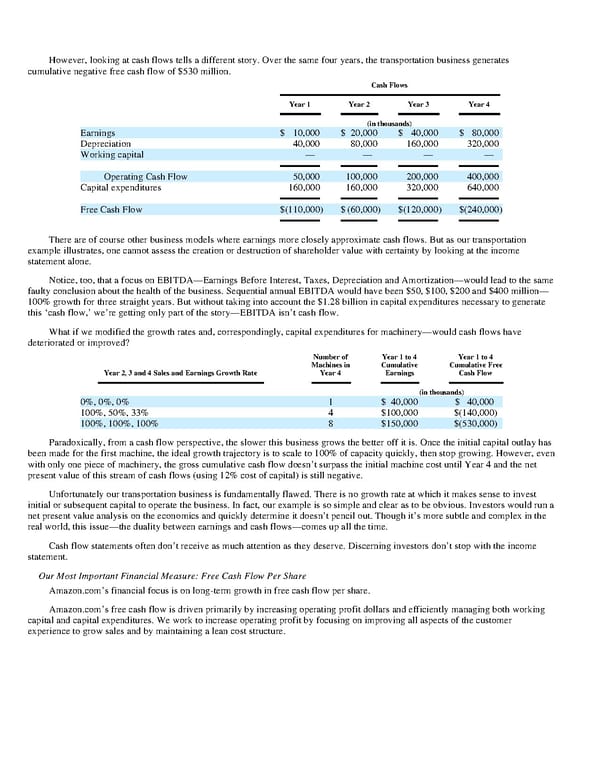However, looking at cash flows tells a different story. Over the same four years, the transportation business generates cumulative negative free cash flow of $530 million. Cash Flows Year 1 Year 2 Year 3 Year 4 (in thousands) Earnings $ 10,000 $ 20,000 $ 40,000 $ 80,000 Depreciation 40,000 80,000 160,000 320,000 Working capital — — — — Operating Cash Flow 50,000 100,000 200,000 400,000 Capital expenditures 160,000 160,000 320,000 640,000 Free Cash Flow $(110,000) $(60,000) $(120,000) $(240,000) There are of course other business models where earnings more closely approximate cash flows. But as our transportation example illustrates, one cannot assess the creation or destruction of shareholder value with certainty by looking at the income statement alone. Notice, too, that a focus on EBITDA—Earnings Before Interest, Taxes, Depreciation and Amortization—would lead to the same faulty conclusion about the health of the business. Sequential annual EBITDA would have been $50, $100, $200 and $400 million— 100% growth for three straight years. But without taking into account the $1.28 billion in capital expenditures necessary to generate this ‘cash flow,’ we’re getting only part of the story—EBITDA isn’t cash flow. What if we modified the growth rates and, correspondingly, capital expenditures for machinery—would cash flows have deteriorated or improved? Number of Year 1 to 4 Year 1 to 4 Machines in Cumulative Cumulative Free Year 2, 3 and 4 Sales and Earnings Growth Rate Year 4 Earnings Cash Flow in thousands) ( 0%, 0%, 0% 1 $ 40,000 $ 40,000 100%, 50%, 33% 4 $100,000 $(140,000) 100%, 100%, 100% 8 $150,000 $(530,000) Paradoxically, from a cash flow perspective, the slower this business grows the better off it is. Once the initial capital outlay has been made for the first machine, the ideal growth trajectory is to scale to 100% of capacity quickly, then stop growing. However, even with only one piece of machinery, the gross cumulative cash flow doesn’t surpass the initial machine cost until Year 4 and the net present value of this stream of cash flows (using 12% cost of capital) is still negative. Unfortunately our transportation business is fundamentally flawed. There is no growth rate at which it makes sense to invest initial or subsequent capital to operate the business. In fact, our example is so simple and clear as to be obvious. Investors would run a net present value analysis on the economics and quickly determine it doesn’t pencil out. Though it’s more subtle and complex in the real world, this issue—the duality between earnings and cash flows—comes up all the time. Cash flow statements often don’t receive as much attention as they deserve. Discerning investors don’t stop with the income statement. Our Most Important Financial Measure: Free Cash Flow Per Share Amazon.com’s financial focus is on long-term growth in free cash flow per share. Amazon.com’s free cash flow is driven primarily by increasing operating profit dollars and efficiently managing both working apital and capital expenditures. We work to increase operating profit by focusing on improving all aspects of the customer c experience to grow sales and by maintaining a lean cost structure.
 Amazon Shareholder Letters 1997-2020 Page 34 Page 36
Amazon Shareholder Letters 1997-2020 Page 34 Page 36